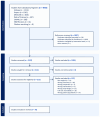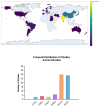The Role of Oral Yeasts in the Development and Progression of Oral Squamous Cell Carcinoma: A Scoping Review
- PMID: 40278081
- PMCID: PMC12028735
- DOI: 10.3390/jof11040260
The Role of Oral Yeasts in the Development and Progression of Oral Squamous Cell Carcinoma: A Scoping Review
Abstract
The role of oral yeasts in oral squamous cell carcinoma (OSCC) has gained attention due to evidence linking fungal dysbiosis to carcinogenesis. While Candida albicans has been the primary focus, emerging studies highlight the importance of non-Candida species yeast genera. This scoping review synthesises the evidence on the role of oral yeasts, including Candida spp. and non-Candida species, in the development and progression of OSCC. A PRISMA-ScR-guided search was conducted in Medline, Embase, EBM Reviews, and CINAHL. Observational and experimental studies involving humans with OSCC, oral potentially malignant disorders (OPMDs), or oral epithelial dysplasia (OED) were included. This review analysed 75 studies. Research on oral yeast in OSCC has progressed since the 1970s, with advancements in identification techniques-from conventional culture methods to metagenomic sequencing and multi-omics approaches-alongside improved animal and cellular models of OSCC. These methodological advancements have identified notable distinctions in the oral mycobiome between carcinomatous and healthy states. Clinical findings reinforce the hypothesis that oral yeasts, particularly Candida spp., actively contribute to the dysplasia-carcinoma sequence. Emerging evidence suggests that oral yeasts may significantly modulate events contributing to OSCC progression. However, further mechanistic studies and robust clinical evidence are essential to establish causality and clarify their role in OSCC.
Keywords: Candida spp.; oral medicine; oral microbiome; oral potentially malignant disorders; oral squamous cell carcinoma; oral yeasts.
Conflict of interest statement
The authors declare no conflicts of interest.
Figures



Similar articles
-
Candida albicans Enhances the Progression of Oral Squamous Cell Carcinoma In Vitro and In Vivo.mBio. 2021 Feb 22;13(1):e0314421. doi: 10.1128/mBio.03144-21. Epub 2022 Jan 4. mBio. 2021. PMID: 35089096 Free PMC article.
-
Investigating Tumor-Infiltrating Lymphocytes in the Microenvironment of Oral Squamous Cell Carcinoma (OSCC) and Oral Potentially Malignant Disorders (OPMDs): Can They Shift Our Perspective? A Scoping Review.J Clin Med. 2025 Jan 18;14(2):606. doi: 10.3390/jcm14020606. J Clin Med. 2025. PMID: 39860614 Free PMC article. Review.
-
Isolation and identification of oral Candida species in potentially malignant disorder and oral squamous cell carcinoma.Natl J Maxillofac Surg. 2021 Sep-Dec;12(3):387-391. doi: 10.4103/njms.NJMS_80_19. Epub 2021 Dec 13. Natl J Maxillofac Surg. 2021. PMID: 35153436 Free PMC article.
-
Investigation of Candidal Species among People Who Suffer from Oral Potentially Malignant Disorders and Oral Squamous Cell Carcinoma.J Pharm Bioallied Sci. 2021 Nov;13(Suppl 2):S1050-S1054. doi: 10.4103/jpbs.jpbs_357_21. Epub 2021 Nov 10. J Pharm Bioallied Sci. 2021. PMID: 35017928 Free PMC article.
-
The evil companion of OSCC: Candida albicans.Oral Dis. 2024 May;30(4):1873-1886. doi: 10.1111/odi.14700. Epub 2023 Aug 2. Oral Dis. 2024. PMID: 37530513 Review.
References
Publication types
Grants and funding
LinkOut - more resources
Full Text Sources
Miscellaneous

